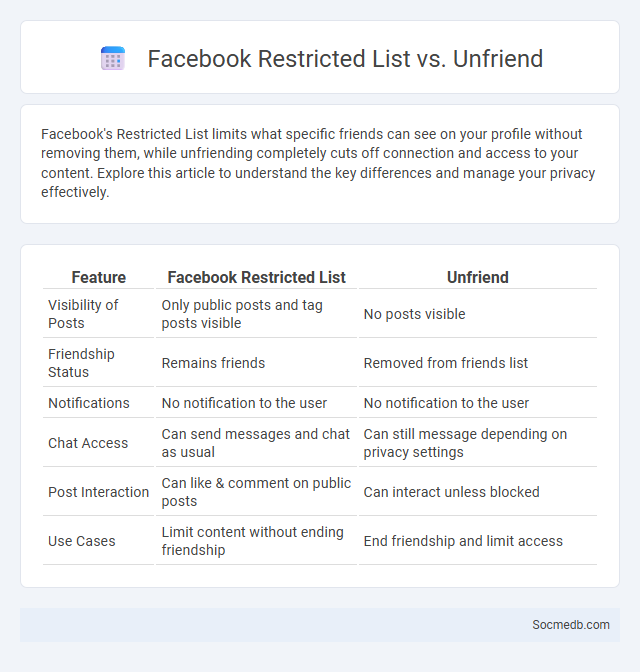
Photo illustration: Facebook Restricted List vs Unfriend
Facebook's Restricted List limits what specific friends can see on your profile without removing them, while unfriending completely cuts off connection and access to your content. Explore this article to understand the key differences and manage your privacy effectively.
Table of Comparison
| Feature | Facebook Restricted List | Unfriend |
|---|---|---|
| Visibility of Posts | Only public posts and tag posts visible | No posts visible |
| Friendship Status | Remains friends | Removed from friends list |
| Notifications | No notification to the user | No notification to the user |
| Chat Access | Can send messages and chat as usual | Can still message depending on privacy settings |
| Post Interaction | Can like & comment on public posts | Can interact unless blocked |
| Use Cases | Limit content without ending friendship | End friendship and limit access |
Understanding Facebook’s Restricted List
Facebook's Restricted List allows users to limit what certain friends can see without unfriending them, providing greater control over personal content visibility. People on this list only view posts and information you share publicly, protecting your private updates from unwanted eyes. Utilizing the Restricted List effectively helps maintain privacy while preserving social connections on the platform.
What Does “Unfriend” Mean on Facebook?
Unfriending on Facebook means removing someone from your friends list, which ends their ability to see your private posts and updates. This action does not notify the person but restricts mutual visibility of personal information and shared content. Understanding what "unfriend" entails helps you manage your social connections and privacy settings effectively on Facebook.
Key Differences: Restricted List vs Unfriend
A Restricted List limits the visibility of your social media content to certain people without notifying them, allowing them to remain your friend but see only public posts or those you tag them in. Unfriending, however, completely removes the person from your friend list, cutting off access to any private content and often sending a clear social signal that the connection has ended. Your choice between using a Restricted List or unfriending depends on the level of privacy and social interaction you want to maintain.
How to Use the Restricted List Effectively
Using the Restricted List on social media platforms allows users to limit a specific individual's interaction without unfriending or blocking them, enhancing privacy with discretion. Prioritize adding contacts who need minimal visibility of your posts or stories, such as acquaintances or colleagues, to maintain a curated audience. Regularly review and update the Restricted List to ensure it reflects your current privacy preferences and social dynamics effectively.
Privacy Implications: Restricted List vs Unfriend
Managing social media connections through Restricted List or Unfriend options significantly impacts user privacy and visibility control. Adding someone to the Restricted List limits their access to your posts without notifying them, preserving the relationship while protecting sensitive content. In contrast, unfriending removes the connection entirely, blocking access and signaling a clear boundary, which can affect social dynamics on platforms like Facebook and Instagram.
When to Use Each Option on Facebook
Facebook provides various content options like status updates, photos, videos, and events, each suited for specific purposes. Use status updates for quick announcements or engaging questions, photos and videos to capture attention and boost interaction, while events are ideal for promoting gatherings or special occasions. Selecting the right format based on audience preferences and message goals maximizes reach and engagement on the platform.
Step-by-Step Guide: Adding Someone to Restricted List
To add someone to your restricted list on social media, navigate to the person's profile and click on the settings or options menu. Select "Add to Restricted List" to limit their access to your posts and updates, ensuring they only see content you choose to share publicly. This feature helps maintain your privacy by controlling what your restricted contacts can view without unfriending or blocking them.
Pros and Cons of Unfriending on Facebook
Unfriending on Facebook can improve mental health by reducing exposure to negativity, toxic behavior, and unproductive interactions, fostering a more positive online environment. However, it may lead to social friction, hurt feelings, and misunderstandings, potentially damaging real-life relationships and limiting social network diversity. Balancing digital boundaries with empathy is essential to maintain healthy personal connections while curating a beneficial social media experience.
Frequently Asked Questions on Facebook Privacy Settings
Facebook privacy settings enable you to control who can see your posts, profile information, and friend list, ensuring your personal data remains secure. Common questions include how to adjust visibility, manage blocking or unfriending users, and configure ad preferences to limit data sharing. Understanding these settings empowers you to tailor your Facebook experience and protect your online privacy effectively.
Choosing the Best Option for Your Facebook Connections
Selecting the best social media platform for your Facebook connections involves analyzing user engagement, privacy settings, and content compatibility to ensure seamless interaction. Platforms like Instagram and WhatsApp offer strong integration with Facebook, enhancing communication through shared features like Stories and direct messaging. Prioritizing tools that support mutual connections and data security can maximize your social networking experience.
 socmedb.com
socmedb.com